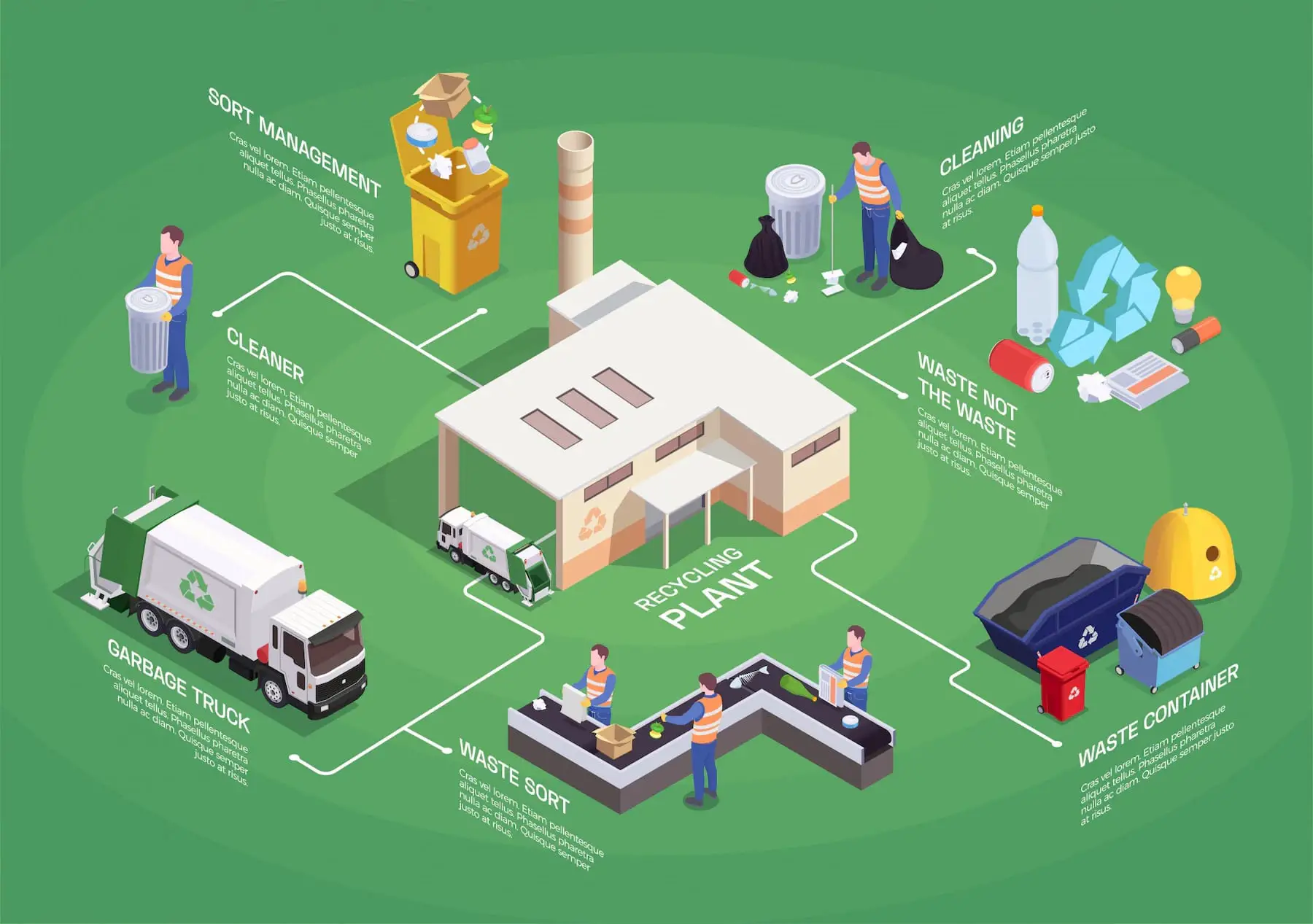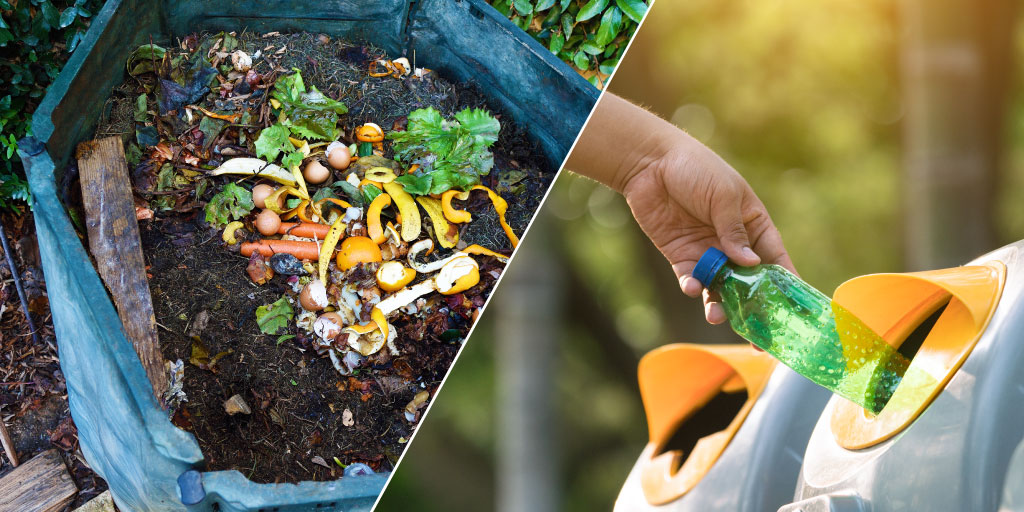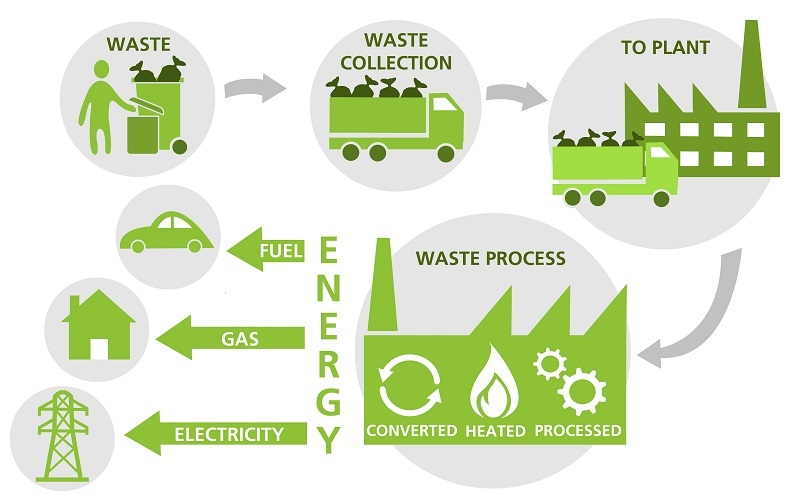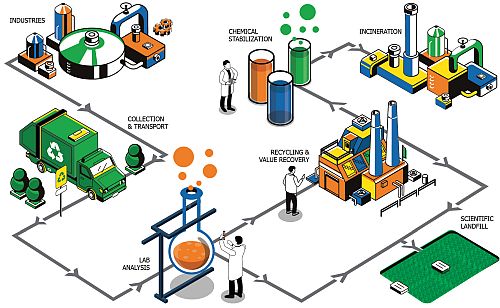The Role of Technology in Waste Management
Technology plays a critical role in waste management by helping to reduce waste generation, improve recycling and reuse, and safely dispose of hazardous waste. Here are some examples of how technology is used in waste management:

Waste Reduction
Waste reduction is an important component of waste management that involves reducing the amount of waste generated in the first place. By reducing waste generation, we can conserve natural resources, reduce energy use, and minimize the environmental impacts of waste disposal. Here are some ways technology can help reduce waste:
1. Product design
Technology can improve product design and manufacturing processes, allowing for more efficient use of materials and reducing waste. For example, 3D printing technology can produce products with less waste and more efficient use of materials compared to traditional manufacturing processes.
2. Inventory management
Technology can be used to improve inventory management, reducing the amount of excess inventory that is generated and potentially wasted. This can help reduce waste and save money for businesses.
3. Digitalization
Technology can help reduce the amount of paper and physical materials used in communication and record-keeping by digitalizing these processes. This can reduce waste and lower costs for businesses.
4. Packaging
Technology can be used to develop more sustainable packaging materials and designs that reduce waste generation, such as reusable or biodegradable packaging.
5. Upcycling and repurposing
Technology can be used to upcycle or repurpose waste materials, turning them into new products or materials rather than disposing of them. For example, plastic waste can create new products such as clothing and furniture.
Overall, technology can play an important role in waste reduction. It does that by improving product design, inventory management, packaging, and promoting upcycling and repurposing waste materials. By reducing waste generation, we can conserve natural resources, reduce energy use, and minimize the environmental impacts of waste disposal.
Recycling and Composting

Recycling and composting are important waste management strategies that can help divert waste from landfills and reduce the environmental impact of waste disposal. Here’s how technology is used in recycling and composting:
1. Sorting
Recycling and composting require the separation of waste into different categories, such as glass, plastic, paper, and organic waste. Technology can be used to improve the efficiency of waste sorting processes, such as by using advanced sorting systems that use sensors and algorithms to identify and separate different types of waste.
2. Processing
After sorting waste, it must be processed into new products or compost. Technology can improve processing efficiency by using advanced machinery to shred and melt recyclable materials or by using advanced composting systems that can process organic waste more quickly and efficiently.
3. Recycling and composting education
Technology can be used to educate the public about the benefits of recycling and composting, as well as how to sort and dispose of waste properly. For example, mobile apps and websites can provide information about recycling and composting guidelines and locations.
4. Chemical recycling
Chemical recycling is a new technology that can convert plastics back into their original chemical building blocks, which can then be used to create new plastics, reducing the need for virgin plastics. This technology is still in development but can potentially greatly improve the efficiency and sustainability of plastic recycling.
5. Closed-loop systems
Closed-loop systems use recycled materials to create new products, reducing the need for virgin materials and minimizing waste. Technology can be used to develop and implement closed-loop systems, such as by using blockchain technology to track the origin and destination of recycled materials.
Overall, technology can play an important role in recycling and composting by improving waste sorting, processing, and education efficiency and effectiveness. By promoting recycling and composting, we can reduce the amount of waste that goes to landfills, conserve natural resources, and reduce the environmental impacts of waste disposal.
Waste-to-energy

Waste-to-energy is a waste management strategy that involves converting waste into energy, typically electricity or heat. Here’s how technology is used in waste-to-energy:
1. Incineration
Incineration is a waste-to-energy technology that involves burning waste at high temperatures to generate steam, which can then generate electricity. Advanced incineration technologies use filters and scrubbers to reduce emissions and minimize environmental impacts.
2. Gasification
Gasification is a waste-to-energy technology that converts waste into a gas, which can then be burned to generate electricity or heat. It is more efficient than incineration and produces less emissions but is also more complex and expensive.
3. Anaerobic digestion
Anaerobic digestion is a waste-to-energy technology that uses microorganisms to break down organic waste, such as food waste and sewage, without oxygen. This process produces biogas, which can be burned to generate electricity or heat.
4. Landfill gas recovery
Landfill gas recovery is a waste-to-energy technology that captures methane gas produced by decomposing organic waste in landfills. This gas can be burned to generate electricity or heat.
5. Plasma gasification
Plasma gasification is a waste-to-energy technology that uses plasma, a high-temperature ionized gas, to convert waste into a gas that can be burned to generate electricity or heat. It is a relatively new technology that is still in development but has the potential to be more efficient and environmentally friendly than other waste-to-energy technologies.
Overall, waste-to-energy technologies can help reduce the amount of waste that goes to landfills while providing a renewable energy source. By using advanced technologies to improve waste-to-energy systems’ efficiency and environmental performance, we can move towards a more sustainable future for waste management. However, it is important to carefully consider these technologies’ environmental impacts and costs and the potential for waste reduction and recycling before implementing waste-to-energy strategies.
Hazardous Waste Management

This involves safe and legal disposal of hazardous waste. Hazardous waste includes toxic, flammable, corrosive, or reactive materials and can pose a significant risk to human health and the environment if not handled properly. Here’s how technology is used in hazardous waste management:
1. Waste treatment
Hazardous waste must be treated to reduce its toxicity or volume before disposal. Technology can be used to develop and implement advanced waste treatment technologies, such as chemical, physical, and biological treatment systems, that can safely and effectively treat hazardous waste.
2. Tracking and monitoring
Hazardous waste must be carefully tracked from its origin to its final disposal location to handle and dispose of it properly. Technology can be used to develop and implement tracking and monitoring systems. For instance, barcode and GPS systems can track the movement of hazardous waste and ensure that it is disposed of under legal and environmental regulations.
3. Storage and transportation
Hazardous waste must be stored and transported in specialized containers that can withstand its corrosive or reactive properties. Technology can be used to develop and implement specialized storage and transportation systems, such as steel drums and tank trucks, that can safely contain and transport hazardous waste.
4. Emergency response
Hazardous waste spills and accidents can pose a significant risk to human health and the environment. Technology can be used to develop and implement emergency response systems. For example, spill containment and cleanup equipment can quickly and safely respond to hazardous waste incidents.
5. Education and training
Hazardous waste management requires specialized knowledge and training to ensure that hazardous waste is handled and disposed of safely and legally. Technology can provide education and training resources, such as online courses and interactive simulations, to hazardous waste management professionals.
Overall, technology plays a critical role in hazardous waste management by improving waste treatment, tracking, storage, and transportation safety and efficiency. Using advanced technologies to improve hazardous waste management practices can reduce the risk of harm to human health and the environment from hazardous waste.
Data Analysis
Data analysis examines and interprets data to uncover patterns, relationships, and insights that can inform decision-making. It can be used in various fields, including business, science, healthcare, and government. Here are some ways technology is used in data analysis:
1. Data collection
Technology can collect large volumes of data from various sources, including sensors, social media, and online platforms. Advanced data collection technologies, like the Internet of Things (IoT), allow for real-time data collection and analysis.
2. Data management
Technology can store and organize data in a way that is easy to access and analyze. Database software and cloud-based platforms are commonly used to manage large volumes of data.
3. Data visualization
Technology can be used to create visual representations of data, such as charts, graphs, and heat maps, that can help users better understand and interpret data.
4. Statistical analysis
Statistical analysis is a common method of data analysis that uses statistical models and algorithms to identify patterns and relationships in data. Technology can be used to automate statistical analysis processes, allowing for more efficient and accurate analysis of large datasets.
5. Machine learning
Machine learning is a type of artificial intelligence that uses algorithms to analyze data and make predictions or decisions based on that data. It can be used in various applications, including fraud detection, customer segmentation, and predictive maintenance.
Overall, technology plays a critical role in data analysis by improving the efficiency, accuracy, and effectiveness of data collection, management, and analysis. By using advanced technologies to improve data analysis practices, we can uncover valuable insights to inform decision-making and drive progress in various fields.
Final Word
Overall, technology plays a critical role in waste management by improving efficiency, reducing waste generation, and promoting environmental sustainability. By using technology to improve waste management practices, we can reduce the environmental impact of waste disposal and move towards a more sustainable future.











